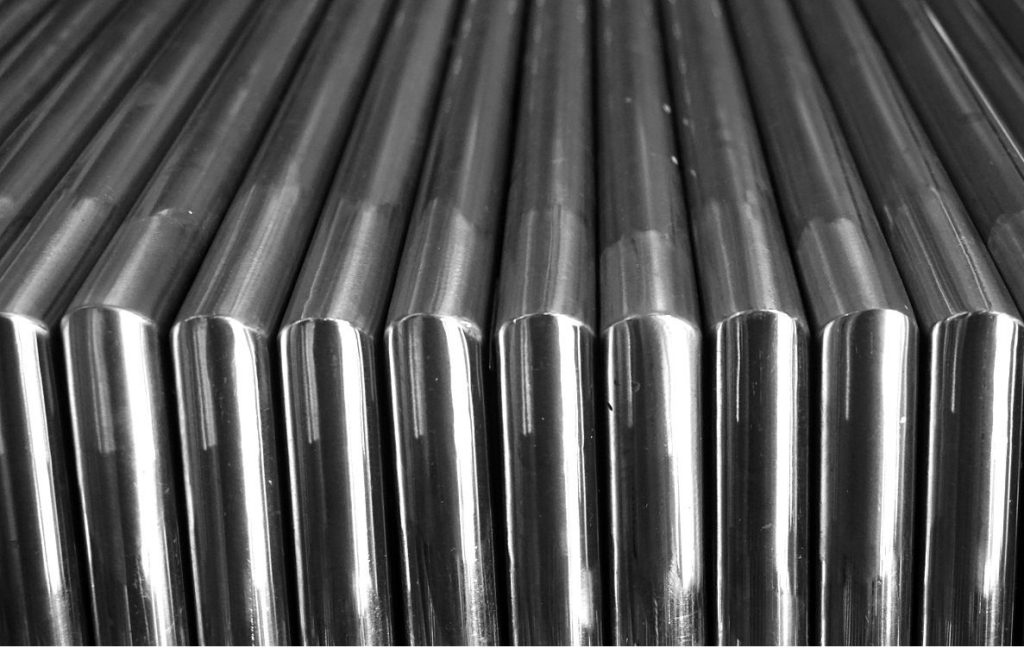
1J22 is an iron-cobalt-vanadium soft magnetic alloy with high saturation magnetic induction intensity. Compared with other soft magnetic materials, this alloy has higher saturation magnetic induction intensity (2.4T) and Curie point (98°C), as well as a larger saturation magnetostriction coefficient (60~100×10-6).
Due to its high saturation magnetic induction strength, the use of 1J22 alloy can greatly reduce the size of the motor while maintaining the same power output. When making electromagnets, 1J22 alloy can also produce greater attraction force under the same cross-sectional area.
All in all, 1J22 alloy has high magnetic properties and can be used in various applications, such as motors and electromagnets, and offers advantages in reducing volume and improving magnetic properties.
Chemical composition of 1J22 precision alloy
Material | 1J22 | |||||||||
chemical composition | C | Minnesota | Si | PAGS | S | cobre | Ni | Co | V | Fe |
≦ 0.04 | ≦0.3 | ≦0.3 | ≦0.02 | ≦0.02 | ≦0.2 | ≦0.5 | 49-51 | 0.8-1.8 | margin | |
Physical properties of 1J22 precision alloy
Material | 1J22 | ||||
Physical property | Density(g/cm3) | Mean linear thermal expansion coefficient(10-6/℃) | Curie point(℃) | Resistivity (μΩ.cm) | Saturation magnetostriction(x10-6) |
8.2 | 8.5(20℃-100℃) | 980 | 40(20℃) | 60~100 | |
Mechanical properties of 1J22 precision alloy
1J22 | Magnetic induction intensity (T) under different magnetic field strength (A/M) | Coercive force HC(A/m) | |||||
B400 | B800 | B1600 | B2400 | B4000 | B8000 | ||
1.6 | 1.8 | 2.0 | 2.1 | 2.15 | 2.2 | 128 | |
Advantages and disadvantages of 1J22 precision alloy
Advantages of 1J22 precision alloy:
1J22 precision alloy has a high Curie temperature, can work at high temperatures, and maintains stable magnetic properties.
The magnetostrictive coefficient is large and suitable for magnetostrictive transducers with high energy output and high working efficiency.
Low resistivity is beneficial to current conduction and magnetic permeability.
Disadvantages of 1J22 precision alloy:
Not suitable for high frequency applications due to lower resistivity.
Easily oxidized and requires protective measures.
The processing performance is poor, but by adding an appropriate amount of nickel or other elements, the processing performance can be improved.
1J22 precision alloy has many advantages, such as high temperature working capability, stable magnetism and high energy output. However, it also has some disadvantages, such as being unsuitable for high-frequency applications, prone to oxidation, and poor processability.
1J22 heat treatment system
For the heat treatment system of 1J22 alloy, the following are the treatment methods for different material forms:
Cold rolled strip sample:
The sample is heated to 850~900℃ with the furnace and kept warm for 3~6 hours.
Cool to 750°C at a rate of 50°C/hour.
Then cool to 300°C at a rate of 180 to 240°C/hour and take out the sample.
The annealing medium uses hydrogen with a dew point not higher than -40°C.
Samples taken from the forging blank:
Raise the temperature of the sample to 1100℃±20℃ with the furnace and keep it warm for 3 to 6 hours.
Cool to 850°C at a rate of 50-100°C/hour and keep warm for 3 hours.
It is then cooled to 700°C at a rate of 30°C/hour.
Finally, cool to 300°C at a rate of 200°C/hour and take out the sample.
The annealing medium uses hydrogen with a dew point not higher than -40°C.
Used for materials requiring higher magnetic induction intensity, lower coercive force, and higher squareness ratio under lower magnetic fields:
The sample is heated to 850℃±10℃ with the furnace and kept warm for 4 hours.
Cool to 750°C at a rate of 50°C/hour and keep warm for 3 hours.
Then cool to 300°C at a rate of 200°C/hour and take out the sample.
During the heat preservation period (750°C), start adding a DC magnetic field of 1240~1600A/m.
The annealing medium uses hydrogen with a dew point not higher than -40°C.
The purpose of these heat treatment systems is to achieve the required magnetic and mechanical
properties of the alloy during processing by controlling changes in temperature and speed.
1J22 precision alloy uses
1J22 precision alloy, also known as iron-nickel-silicon alloy, has excellent magnetic and mechanical properties and is therefore used in many fields. Here are some common uses of 1J22 precision alloy:
Magnetic components: Because 1J22 alloy has high magnetic induction intensity and low coercive force, it is often used to manufacture magnetic components, such as sensors, magnetic heads, inductors, transformers, etc.
Magnetic field control equipment: 1J22 alloy has higher magnetic induction intensity under lower magnetic fields, so it is often used in magnetic field control equipment, including magnetic field sensors, magnetic control valves, magnetic drive systems, etc.
Magnetic storage devices: Since 1J22 alloy has low coercivity and good magnetic induction intensity, it can be used to manufacture magnetic storage devices, such as hard drives, magnetic cards, tapes, etc.
High-sensitivity sensor: The high magnetic induction intensity and low coercivity of 1J22 alloy make it an ideal material for manufacturing high-sensitivity sensors, especially in measuring magnetic fields and magnetic substances.
In general, the main uses of 1J22 precision alloy are in fields related to magnetism, including applications such as magnetic component manufacturing, magnetic field control equipment, magnetic storage devices and high-sensitivity sensors.

